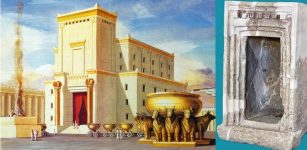Painted Komkom Vase With Longest Hieroglyphic Text Unearthed In Belize
Conny Waters - AncientPages.com - An ancient painted vase, which bears one of the longest hieroglyphic texts unearthed in Belize of the Central America , is offering new clues into the mysterious breakdown of ancient Maya civilization, researchers say.
The shattered vessel (some pieces are missing) — found amid artifacts associated with the abandonment of the royal palace complex at the Maya site of Baking Pot in Belize — was discovered in excavations directed by Julie Hoggarth, Ph.D., assistant professor of anthropology in Baylor’s College of Arts & Sciences.
 Fragments of the Komkom Vase showing the A.D. 812 Long Count calendar date. source
Fragments of the Komkom Vase showing the A.D. 812 Long Count calendar date. source
The first fragment of the vessel had the emblem hieroglyph for “Yaxha” — an ancient Maya city and ceremonial center in Guatemala.
The vase’s size — about nine inches — “makes it all the more amazing,” Hoggarth said in a press release. “At its full length, it would have had 202 hieroglyphic blocks, making it the longest Pre-Columbian text discovered in Belize and among the top 10 longest Classic Period (A.D. 250 to 1000) texts ever discovered in the Maya area.”
The characters on longer texts generally are much larger, often carved on monuments or staircases. The longest consists of some 2,200 hieroglyphs. The 82 fragments of the Komkom Vase, named after the royal owner of the vase, were found in a large ritual deposit that had been covered with collapsed limestone blocks from adjacent structures after the site’s abandonment.
Researchers painstakingly pieced them together and took a flat “rollout” photo — “kind of like putting together a jigsaw puzzle” — which was digitized for the book’s images, Hoggarth said.
 Fragments of the Komkom Vase showing the A.D. 812 Long Count calendar date. source
Fragments of the Komkom Vase showing the A.D. 812 Long Count calendar date. source
The vase would have been used as a ruler’s drinking vessel, Hoggarth said.
“On other vessels, they sometimes included a description of the use, like some say they were made as the frothy cacao drinking vessel for a particular ruler,” she said. “But in the case of this vase, it’s not telling us the use.”
A recently published book, with photos, illustrations and detailed translation and analysis of the hieroglyphs and text, tells of political upheaval, alliances, warfare, rituals, Maya rulers’ genealogy — and “propaganda about royalty” — during an era of “godly kings,” Hoggarth said.
The multicolored ceramic vase, which includes a dedication date of A.D. 812, makes no mention of the weather, economy and the lives of commoners. Ceremonial centers like the one at Baking Pot generally included such structures as temples, shrines, ball courts and markets, as well as off-limits residences of royalty. One account is believed to tell of the torching of Yaxha and the flight of a ruler to a place “where mosquitoes/flies abound.”
The reason for abandonment of Baking Pot — named by English explorers who spotted the Maya boiling chicle in pots — still is being investigated, Hoggarth said.
“Some archaeologists have speculated warfare as a main cause, but we don’t have evidence of that,” she said.
See also:
More Archaeology News
Whatever the reason for leaving Baking Pot, the Maya smashed pottery, musical instruments and other items as part of an abandonment ritual, according to researchers.
“Many indigenous groups in the Americas believe that living spirits inhabit inanimate objects, and that putting a hole in a ceramic item or breaking the head off a figurine releases the spirit,” Hoggarth said.
Written by Conny Waters – AncientPages.com Staff Writer




















